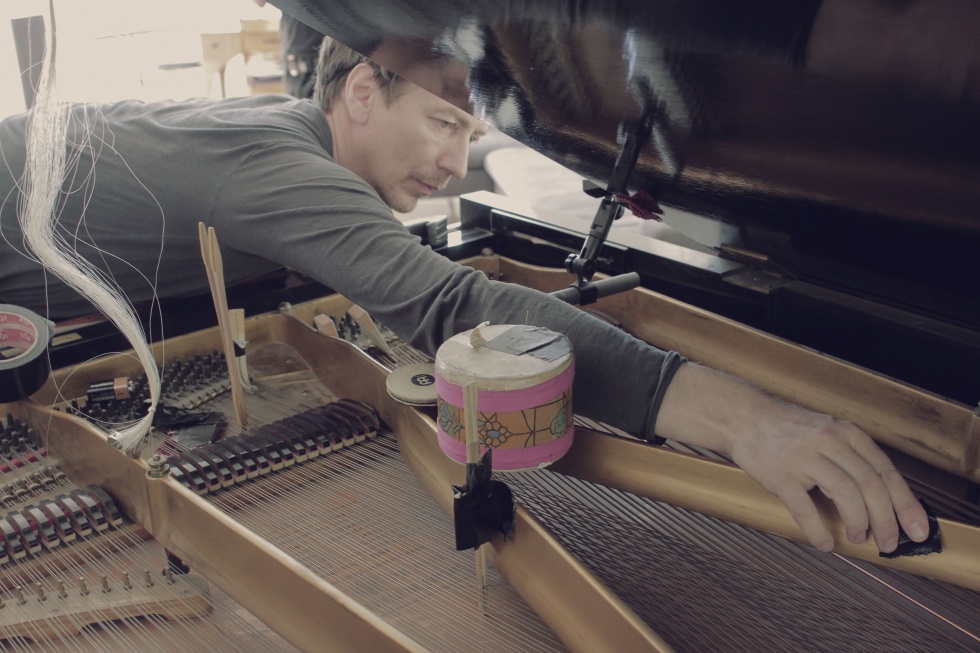
Boiler Room are launching a brand new series called In Stereo, allowing us to present a different class of music and musicians that we cherish, shot with high-end production values and mixed-down audio in locations – living rooms, studios, concert halls – that stand outside what we are traditionally known for. We kick off with a broadcast featuring Hauschka, a fascinating master of the prepared piano. Head HERE for more info on his performance, scroll down for the recording, or read on for an in-depth look at his career – including two filmed BTS pieces featuring the man himself speaking about his gear and approach to music:
Super-magnets, art erasers, rubber tubing, Tic-Tac boxes, ping-pong balls, duct tape, aluminium foil, leather straps, marbles, and vibrating sex toys: these are just a few of the assorted oddities that German musician Hauschka uses to create his singular sound on prepared piano. With a career that’s taken him from German hip-hop to drum-n-bass, Hauschka’s music challenges the perceived boundaries between high and low culture, having appeared at festivals alongside the likes of Zomby and Dixon as well as touring with double Grammy-winning violinist Hilary Hahn.
His newest LP Abandoned City was made entirely on the piano, utilizing disruptive methods to alter the timbre, sustain, and reverb. The results are by turns lush and oppressive, exposing new melodic colours and percussive undertones on repeated listens. There are plenty of surprising details that make you question how one man can wring so much variety from a single piano.
Hauschka was born Volker Bertelmann in Ferndorf, a tiny village in the German town Kreuztal, where he studied piano starting at the age of nine. Bertelmann eventually decided the piano simply wasn’t a cool enough instrument to justify all the practice and attention and decided to shift his focus to synthesizers, although he continued to take lessons for the next ten years. In his twenties Hauschka was a member of German hip-hop group God’s Favourite Dog as both rapper and keyboard player – the group signed with Sony and toured with famous German rappers Die Fantastischen Vier, but they’re remembered today primarily due to Hauschka’s involvement. He also worked in the short-lived Nonex, a drum-n-bass outfit that released two albums before disbanding. After being dropped by a major label, Hauschka says he set out to write music without traditional song structures or vocals, taking a responsibility for the whole sound and eventually leading him to the prepared piano.
“I needed a way of working on something that gave me limitless ability to use the sounds inside of a piano.”
Of the various musicians who have explored the possibilities of prepared piano, John Cage‘s shadow looms largest. Beginning in 1940, the experimental luminary and innovator composed more than twenty pieces for the modified instrument, using simple additions like screws and bolts or, more exotically, bamboo strips. Cage’s interest in utilizing a prepared piano was originally an issue of functionality – while writing the score to Syvilla Fort’s dance piece Bacchanale, he realized the space afforded to him was too small to hold the size of ensemble he typically used for percussion pieces at the time. Forced to work with only a piano, Cage went about altering the instrument to achieve maximum percussive impact.
Hauschka’s introduction to the prepared piano began in almost the exact same way, although Bertelmann claims he was entirely unaware of Cage’s work when first altering the instrument. His initial experiments were borne out of a frustration with overcrowding, wanting to replicate numerous other forms of instrumentation without actually having to use the actual instrument. He’s said before of this studio discovery: “I needed a way of working on something that gave me limitless ability to use the sounds inside of a piano.” He had already become fascinated with electronic music and the likes of Mouse on Mars and Oval, as well as labels like Raster-Noton and Kompakt, and sought to create similarly dense soundscapes using just the piano.
Though preparing a piano is a time-consuming process with significant variability in terms of reproduction, Hauschka has seemingly sidestepped these limitations, recording twelve albums in as many years. He approaches the piano like a bedroom producer with an endless set of presets and a limitless appetite for experimentation, treating it as a “sound machine” to be exploited rather than being limited to the traditional palette of piano music. That exploratory tendency has been embraced by various DJs and producers and resulted in Hauschka’s emergence as an electronic darling, leading to remixes by Ricardo Villalobos, Michael Mayer, patten, and Matthew Herbert.
Hauschka’s compositional process is a punkish approach to the piano, attempting to defy what he’s called the “upper-class classical world” of piano builders like Steinway & Sons by breaking the instrument. His music retains this palpable sense of destruction even during the most beautiful passages. He often improvises when playing live, and in this BTS video describes the experience as being something akin to speed-dating or commuting, with all the included unpredictabilities:
“It’s as if you’re going to work every day on the same road, and suddenly it’s blocked, and you have to go another way.”
– Special thanks to Annette Gentz Music & Film Arts for their time & Michael Buchholz for mixing the recording.